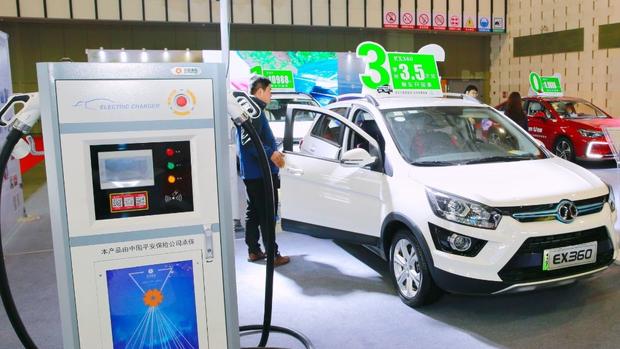 In this undated photo, consumers visit an exhibition of new energy vehicles in Nanjing, Jiangsu province, in March 2019. (CHENG JIABEI / FOR CHINA DAILY)
In this undated photo, consumers visit an exhibition of new energy vehicles in Nanjing, Jiangsu province, in March 2019. (CHENG JIABEI / FOR CHINA DAILY)
The phrase "new energy vehicles", which has been repeated in the Government Work Report over the past seven years, did not appear in the report delivered at this year's annual two sessions, which concluded on Thursday.
That does not mean, however, that the sector is losing Chinese government support. Instead, the focus is changing from car production and sales to their use. "Efforts should be made to build more charging piles and battery swap stations," reads the report, which outlines the nation's priority tasks.
Analysts said easier car use would be of more help to persuade customers to choose electric cars. Many people, especially in big cities, have dispelled their doubts about safety and quality. For example, in Beijing, around half a million people are lining up to get their electric car license plates.
Gasoline cars run for 500-600 kilometers and people don't complain. That is because they can always find a gas station within 10 km. Now electric cars have a similar driving range as well, but people are discussing whether they need cars capable of driving 1,000 km. That is, the number of charging pillars are much less than gas stations.
Stephan Woellenstein, CEO of Volkswagen Group China
China has been promoting the sector since 2009 and more than 5.5 million electric cars and plug-in hybrids were on its roads by the end of 2020. Last year, despite the COVID-19 pandemic, almost 1.37 million were sold and the figure is expected to hit 1.8 million this year.
ALSO READ: Shanghai to make big splash in NEV sector
China has been the largest market for such vehicles since it overtook the United States in 2015, according to statistics from the Ministry of Industry and Information Technology.
China's subsidies, which are estimated to total hundreds of billions of yuan, gave a boost in the early stages of the sector by motivating carmakers to offer electric vehicles and gasoline car owners to switch to electric.
But as the authorities are to phase out subsidies by the end of 2022, measures that enable convenient car use are becoming more important.
By the end of 2020, there were 1.68 million charging piles in the country. That means more than three vehicles have to share a charging pile.
The ratio will fall down to around 2.5 this year, said Tong Zongqi, a senior executive at the country's charging infrastructure alliance.
Carmakers are speeding up their efforts toward electrification, and they believe that quality vehicles and sound infrastructure are more attractive than subsidies.
Stephan Woellenstein, CEO of Volkswagen Group China, said if charging is easily accessible, customers will be less worried about electric cars' ranges.
"Gasoline cars run for 500-600 kilometers and people don't complain. That is because they can always find a gas station within 10 km.
"Now electric cars have a similar driving range as well, but people are discussing whether they need cars capable of driving 1,000 km. That is, the number of charging pillars are much less than gas stations."
READ MORE: 'New track, new direction, endless possibilities'
As one of the largest car groups worldwide, Volkswagen aims to sell at least 1 million electric cars and plug-in hybrids a year in China by 2025.
It has installed more than 8,000 charging piles at more than 2,000 dealerships across the country. It has also built a joint venture with local Chinese companies, which is expected to build 500 charging stations by the end of this year.
Chinese companies, including electric car startup Nio, are pioneering battery swap technology. It allows a car to replace a fully charged battery in less than three minutes, when it usually takes hours to get a vehicle fully charged.
The technology enables Nio to sell vehicles without batteries, which they can rent and get empty ones swapped. This innovation was included in Fortune's 2020 "Change the World" list.
Nio said it will soon launch second-generation battery swap stations, which will work even faster. It is to build a total of at least 500 stations by the end of this year. More than 190 stations were built by the end of February 2021 across 76 cities.
Another reason for the central government's shift of focus from car production to car use is because local authorities are already enthusiastic about the sector.
Cities, including Hefei in Anhui province, have made the sector one of their top-pillar industries, thanks to the huge profits from its investment in New York-listed Nio.
Some places have been confronted with severe overcapacity. One example is that carmakers in Jiangsu province produced 100,800 new energy vehicles in 2020, while its capacity, including some to be built, totaled 2.85 million, according to the Economic Observer newspaper.
Data show that from 2015 to the first half of 2017, there were more than 200 new energy vehicle projects in the country, some planned and some under construction.
READ MORE: Cabinet boost for new energy vehicles
They involved a projected investment of 1.03 trillion yuan (US$158.5 billion) and a combined planned production capacity of 21.24 million vehicles.
Late last year, the National Development and Reform Commission launched an investigation into such projects planned since 2015, as a sign of the top authority's prudence about the sector.
Roy Lu, director of Gasgoo Auto Research Institute, said local governments were more enthusiastic about the sector several years ago. They started to show restraint when a project involving US carmaker Saleen in Jiangsu province was found to be bogus in 2019.


